Case Fan Bearing Types – Differences And Comparison
Optimizing the airflow of your PC is one of the most important tasks as a whole in the PC building process. Unfortunately, it is also the one that gets neglected far too easily by novice builders. Air cooling is still the most efficient and cost-effective way of cooling your PC components, and the airflow of the case plays a vital role in the air cooling performance of your heatsinks and graphics cards in the case. This trend carries on with liquid coolers as well, as the radiators of those coolers also need a lot of air moving through them in order to carry out their function effectively.
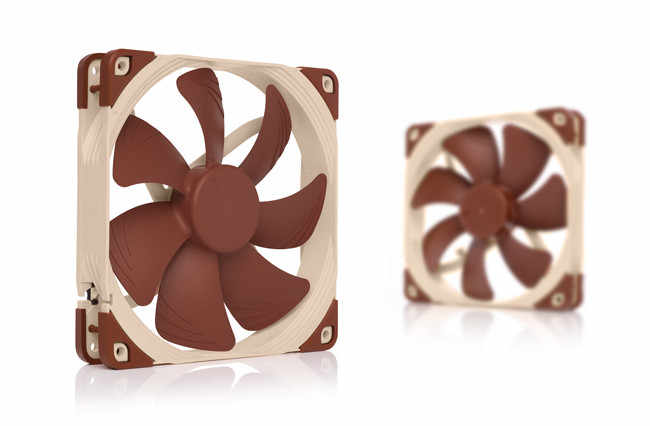
This is where case fans come in. Not only are case fans some of the most important components of any PC build, but they are also quite easily one of the most under-rated ones. Novice builders, as well as enthusiasts, can fall to a bad idea of saving a few bucks on case fans by buying cheap quality ones, or by buying fewer fans than they need. High-quality case fans do cost a bit much as far as fans go, but they are often the ones that provide the highest performance, quietest noise levels, and long lifespans. The bearing type of case fans plays an important role in all three of these parameters and it is important to know the differences between the three bearing types before making a purchase decision.
Fan Bearings
So what exactly are these bearings? To understand this we first have to dissect the anatomy of the fan itself. Being a relatively simple component, there is not that much going on under the hood. The fan works by using a rotor that spins on a bearing to displace air. For a fan to be reliable, the function of the bearing is extremely important in the overall fan design. This is because the fan can rotate thousands of times per minute and in each rotation, there is a large amount of stress being put on the bearing. Furthermore, the fan is also supposed to have a lifetime of many years. That can mean hundreds of thousands of rotations of the fan, and the bearings inside have to keep up with that level of performance.
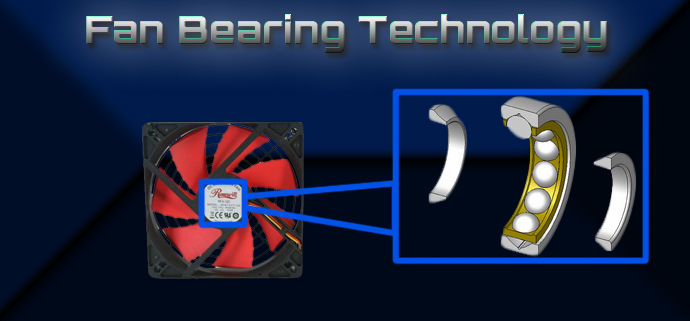
When we talk about fan bearings, we have to keep a few things in mind. Firstly, we have to understand what type of bearing the fan uses. This could be Sleeve, Ball, and Fluid-Dynamic bearings with some minor variations. After that, you have to look at the lifespan of the fan with respect to the bearings that are being used inside of it. Moreover, the noise levels generated by the fans will also have to be considered, which will determine whether the bearing is doing its job properly and what level of obstruction is the motor usually facing. Mounting orientation of the fans can also be a thing to consider in some sleeve bearing fans because there are certain differences that have been observed in the lifespan of these fans depending on their orientation.
Here are the different types of bearings and how they work.
Sleeve Bearings
The central shaft of a sleeve bearing fan is enclosed in a structure that resembles a sleeve, thus the name. Oil is used for lubrication and ease of rotation. The sleeve ensures that the rotor is kept in the right position and it also preserves the gap between the rotor and the stator. Moreover, there is a certain amount of protection that is offered by the sleeve to the shaft.
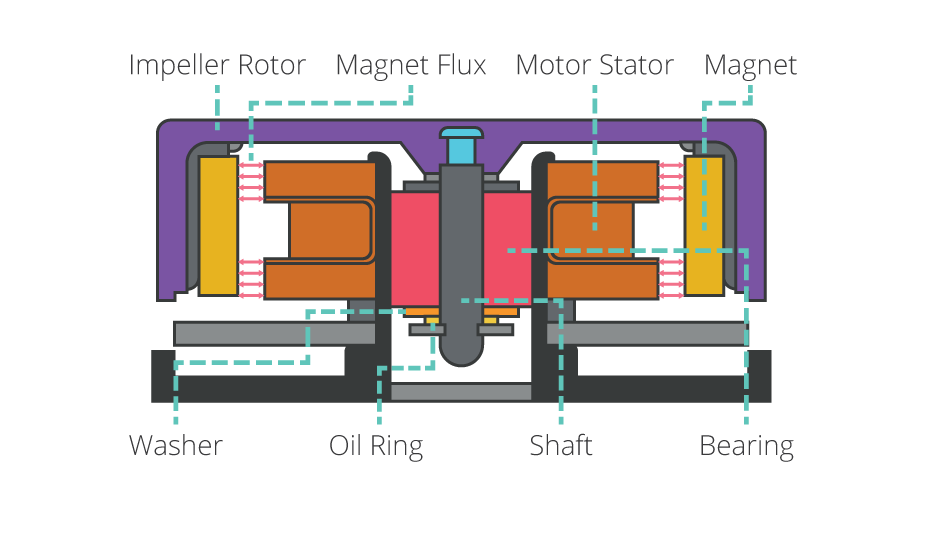
Sleeve bearing fans are usually inexpensive, simple, and quite rugged. This means that these fans are used in a large number of applications. They are simple in design which means that they are less prone to malfunction. Sleeve bearing fans are also quite rugged which means that they can work in harsh environments and therefore have many industrial applications. Sleeve bearing fans are also some of the quietest fans around which is always a nice feature when it comes to case fans. Due to their simple nature, they are often used in small toys or gadgets.
Sleeve bearing fans are also the most common type of case fans in the computer world. They are affordable, simple to manufacture, have a quiet sound profile and have a reasonable lifespan of around 40K hours (at 60C). They do have a tendency to develop whirring noises down the line when they are mounted in a horizontal position. This is why sleeve bearing fans are best mounted in a vertical position, the reason for this exception being the lubricant system.
There are some concerning aspects of sleeve bearing fans as well. These fans tend to fail catastrophically, and often without warning. They can also suffer from immediate failures at temperatures over 70C due to the way their lubrication system is organized. As mentioned before, they do suffer from strong deterioration when installed in non-vertical positions.
Ball Bearings
Ball Bearing fan design is a way to combat some of the deficiencies of sleeve-bearing fan design. Ball-bearing fan designs use a ring of balls around the shaft to solve the problems of rotor wobble and uneven wear. The bearings offer reduced friction as compared to sleeve designs and the springs can assist with any tilt in the fan that may be induced by the rotor’s weight. Most fan motor designs have two bearings separated by springs. If the springs are placed all the way around the shaft, the device can be operated at any angle or orientation which results in a more reliable design.
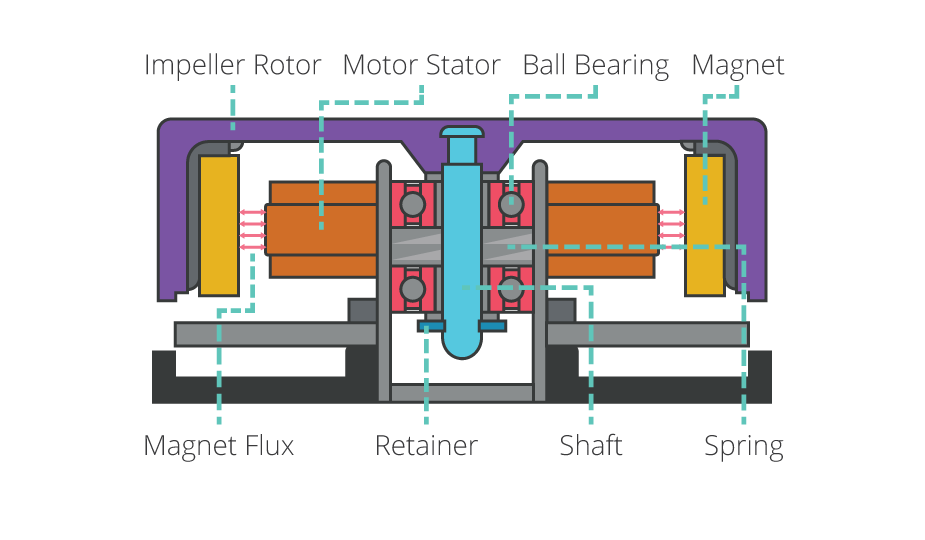
In general, ball bearing fans are less prone to wear and tear and can operate at higher temperatures in any orientation. However, ball bearing fans are more expensive to manufacture to their slightly more complex nature, and therefore are less rugged as well. They are also a bit more noisy when compared to the sleeve bearing fans. Ball-bearing fans are widely used in industrial applications such as blowers for industrial dryers or in cooling systems of electronic components. Cooled server and enterprise applications tend to favor ball bearing fans as well for their performance and longevity.
Due to their advanced design, ball bearings last considerably longer than sleeve bearing fans, averaging around 60-75K hours (at 60C) compared to the 40K of sleeve bearing fans. Ball bearings can also tolerate higher temperatures better than sleeve bearings. They can also be mounted in any orientation with no concern for degradation. Ball-bearing fans use a point-contact bearing system rather than line-contact which generates less friction. However, they are a bit louder as mentioned before, and their lubricant system can fail slowly over time causing a gradual increase in noise.
Fluid Bearings
Fluid bearings are essentially a modified version of a sleeve bearing design. They use the fan’s own rotation to stabilize the fan and dramatically improve lubrication performance, and that results in an extremely quiet fan with a long lifespan.
Fluid bearings use a fluid cycling technology and as a result, they tend to bring the lowest noise level out of all types of bearings discussed here. They are also great in terms of lifespan as these bearings have the highest expected lifespan out of all the bearing types listed here. The lifespan of fluid bearings can reach anywhere from 100K hours on the low end (40-70C) to upwards of 300K hours which is an extremely long time for a spinning fan.
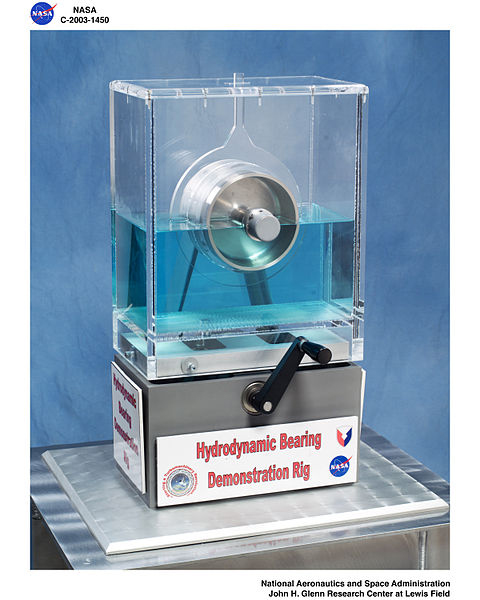
Fans that use the fluid-dynamic setups remain very quiet throughout their lifespan. They can also be mounted in any direction and have no axial preference like sleeve fans. Moreover, fluid-dynamic bearings are generally preferred for sustainability and relative silence in high-performance PCs and machines of this nature. They can also push the same or more air (in CFM) as any other fans of their class. This makes the fluid-dynamic fan bearings the best in all departments.
There is a significant drawback to this technology though. The fluid-dynamic fans are a bit more expensive than comparable fans that use the other technologies. This can mean a few bucks here and there at a consumer level which is a good bargain for a fan with a long lifespan with silent operation. The story might be a bit different at the industrial level though.
Differences
The main differences between the three types of bearings lie not in their performance as a fan, but mainly in their noise levels, lifespans, and their prices. At the bottom of the rack, we have sleeve bearing fans. These fans tend to have reasonable lifespans that are unremarkable, are quiet at the start of their lifespan, and are really affordable, so a bulk of the PC case fan market still employs this bearing design.
Next in line we have the ball bearing fans which improve upon the lifespan of the sleeve bearing fans quite significantly, but they tend to be a bit louder and a bit more expensive too. Finally, we have the fluid bearing fans which have the lowest noise levels and the longest lifespans among all three but also tend to be more expensive than either of the aforementioned bearing types.
The selection of a particular fan bearing option does depend on your case choice as well. If your case has fans that are 140mm and larger, you shouldn’t experience any intolerable noise levels and therefore can buy fans that use sleeve bearing or ball bearing. However, if you have an affordable case and are restricted to multiple 120mm fans then it is probably worth investing in fluid bearing fans for added longevity and lower noise levels. At one point you do hit diminishing returns, so it would be wise to balance the budget of the case with the fans together so you do not end up spending more on fluid bearing fans than the actual case.
Optimizing Airflow
Configuring the airflow of your case is an extremely important part of building a PC, and case fans play a very important role in them. First, you have to decide what kind of pressure you want to build up in the system. Most PC enthusiasts lean towards positive pressure that reduces the build-up of dust in the PC and generally provides better thermals as well.
To create a positive pressure inside the system, the number of intake fans has to be higher than the number of exhaust fans in the system. Negative pressure systems have more exhaust fans than intake and that can be a good configuration too under certain conditions. Negative pressure has a huge drawback of dust build-up due to the fact that air is forced into the case through small nooks and crevices so dust build-up is quite a significant problem.
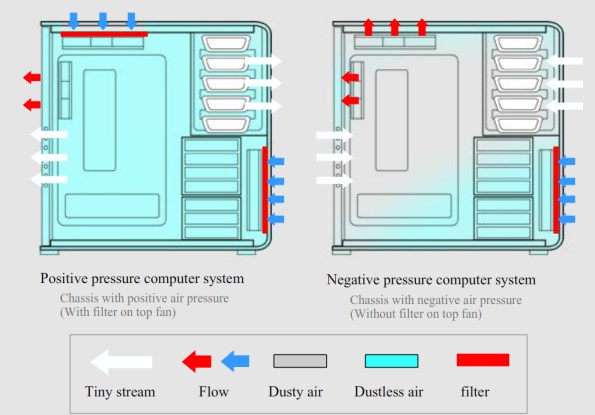
Furthermore, case fans have to be selected according to your need. There are two main categories of PC fans on the market. These include the airflow-focused fans and the static-pressure fans. The airflow-focused fans are better for case ventilation since they are capable of moving a large amount of air without getting too loud if they have one of the better bearing types. Static-pressure fans are meant to be installed on radiators for water-cooling since radiators are semi-permeable obstacles in the path of airflow. Installing normal airflow-focused case fans on a radiator might result in air leaking from the sides of the radiator because the fan does not have enough static-pressure to push the air through the fins of the heatsink. These factors must be considered before making a purchase decision on a PC fan. Additionally, our recommended selection of PC case fans can also be useful in this regard.
Final Words
PC fans use a system of bearings in order to keep the moving blades of the fans functioning efficiently and smoothly. Three common types of bearings are available in various products on the market today, and the differences between them are important to understand before making a purchase decision. While basic sleeve bearing fans may be adequate for most PC builds and other applications, buyers might want to step up to ball-bearing or fluid bearing fans for a higher price if they want better acoustic performance and a longer lifespan of the fan.





